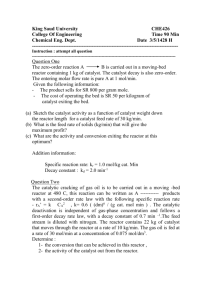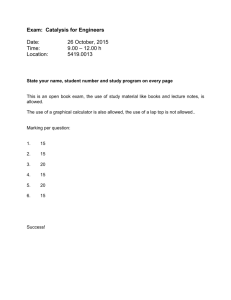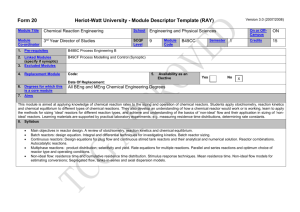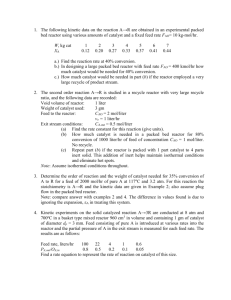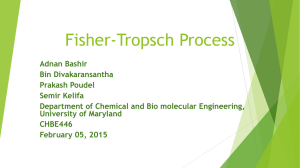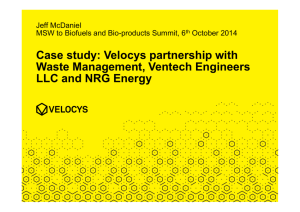Velocys Microchannel Technology
advertisement
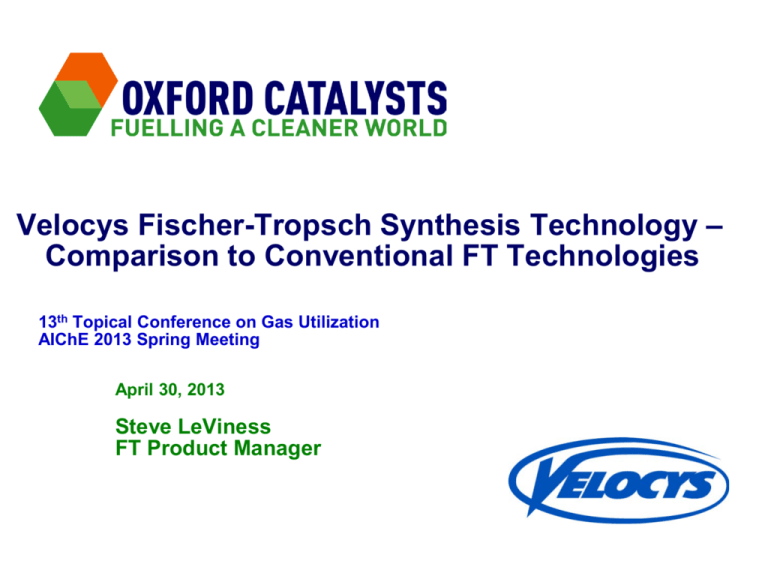
Velocys Fischer-Tropsch Synthesis Technology – Comparison to Conventional FT Technologies 13th Topical Conference on Gas Utilization AIChE 2013 Spring Meeting April 30, 2013 Steve LeViness FT Product Manager Presentation Outline Who is Velocys Conventional FT Technologies – Multi-tubular Fixed Bed Reactors – Slurry Bubble Column Reactors Velocys Microchannel FT Technology 2 About Oxford Catalysts Group Unique innovative technology solution for distributed scale GTL World-class pedigree − 15+ yrs of development – University of Oxford: top global research centre; largest chemistry department in Western World – Battelle: world’s largest independent science and technology organisation Global leader – World’s strongest microchannel IP portfolio (>800 patents) >7,500 granted GTL claims and 6,000 pending Critical mass: ~90 employees – Catalyst development near Oxford, UK – Process technology development near Columbus, Ohio, USA Oxford Catalysts Group listed on AIM (LSE:OCG) – sells under Velocys brand 3 Conventional Fixed Bed Reactors Principles of design and operation – – – – – Catalyst-particles in long, small diameter tubes Syngas inlet at top 2-phase mixture (wax + gas) exits bottom Boiler feed water in reactor shell Heat removal by steam generation Strong points – – – – – – – – Long established scale-up methodology Strong economy of scale to maximum size Plug flow behavior “Simple” operations Very high strength catalyst not required Generally excellent catalyst/wax separation Bed inlet acts as poison removal zone Simple, in-situ catalyst regeneration process 4 Conventional Fixed Bed Reactors - Negatives Sub-optimal catalyst particle size vs. differential pressure trade-offs – FT selectivity considerations strongly favor small particles (< 0.5 mm) – Tube length and DP considerations strongly favor large particle (> 2-3 mm) – Typical 1-2 mm particles operate near/in mass transfer limited conditions Sub-optimal reactor tube diameter – Heat removal at high reaction rates requires small diameters (< 0.5”) – Reactor cost and weight requires large diameters (>2”) – Typical ~1” diameter tubes operate under heat transfer limited conditions Reactor must be taken off-line for catalyst regeneration – On stream service factor debit for all but the largest plants Reactor must be shut-down for catalyst replacement – On stream service factor debit for all but the largest plants Reactors are very large and heavy per unit of production 5 Conventional Fixed Bed Reactors – Implications Reaction rate is limited by heat transfer considerations – Control of hot spots requires relatively low average temperatures – Reactors are susceptible to thermal runaway under upset conditions – Exothermic regeneration procedures are also tricky High recycle to fresh feed ratios required – typically 3-5 – Maintain high gas velocities in tubes – Minimize reactant concentration gradients through catalyst bed – Large recycle compressors and power loads Maximum productivity per reactor limited to about 6,000 BPD (Shell) – Reactors are still 20-25 ft in diameter, ~40 ft tube lengths, 30,000 tubes, 1200 tonnes Small plant service factor considerations lead to dis-economies of scale – Multiple reactors required to avoid severe downtime issues Even relatively small capacity reactors difficult to modularize – BP’s 300 BPD demo plant (AK) had 2 reactors, ~5-6 ft OD by ~50 ft tall 6 Tubular Reactor Score Card Property Flow Patterns Reactor Scale-up Methodology Heat Transfer Limitations Mass Transfer Limitations Thermal Stability Catalyst Reaction Rate Reactor Volumetric Production Differential Pressure Gas Recycle Requirements Catalyst Wax Separation Catalyst Strength Requirement Regeneration Equipment Regeneration Ease Catalyst Replacement On-stream Factor Feed Poisoning Upset Robustness Shutdown Robustness Modularization Mass Manufacturing Economies Boiler Feed Water Quality Capital Cost per BPD Tubular Fixed Bed Slurry Bubble Column Velocys Microchannel Plug flow Easy/known Very high High Poor Low Low Moderate High Excellent Low Minimal Difficult Offline-slow Low Local Low Good Low Low-Medium Low High 7 Slurry Bubble Column Reactors Principles of design and operation – – – – – – Catalyst-wax slurry in reactor shell Low catalyst volume fraction (< 20%) Syngas bubbled through slurry Wax removal by internal filtration Boiler feed water in reactor tubes Heat removal by steam generation Strong points – – – – – – – – – Isothermal behavior – thermally stable Generally robust to upsets Very strong economy of scale Accommodates high activity catalysts Low DP (liquid head and gas distributor) Small particles not mass transfer limited Catalyst replacement on line High on-stream factor Tail gas recycle only to achieve high conversion 8 Slurry Bubble Column Reactors - Negatives Reactor hydrodynamics are strong function of reactor diameter – Scale-up methodology not generally understood – Large reactors relatively well mixed – No inlet guard bed effect – all catalyst poisoned equally Significant solids handling issues – – – – – – – Addition and removal of small (50-100 micron) catalyst powder Potential catalyst settling on shutdown (and in operation) Near uniform gas distribution across 5-10 m diameter surface required Catalyst-wax separation (filtration) potentially problematic Very robust catalyst particles required – mechanically and chemically Potential catalyst entrainment – overhead losses in gas outlet Possibility of slurry “burp” overhead during severe pressure and/or flow upset Complicated catalyst regeneration equipment and procedures – Multi-step, batch processing – Catalyst settling, wax removal, fluidized bed oxidation and reduction, catalyst wax mixing 9 Slurry Bubble Column Reactors – Implications Very large high capacity reactors possible – 10 m diameter by 60 m tall, 2200 MT, 17,000 BPD (Sasol - Oryx) – Future plants based on ~24,000 BPD from same scale reactors Significant scale-up risk – Only Sasol (10 m) and Synfuels China (5 m) have experience with large reactors Sasol not licensing, Synfuels China employs iron catalyst – GTL.F1 only comfortable increasing diameter by ~2 times Ran a 1,000 BPD demo, “only” planning 2,000-4,000 BPD commercial reactors – Several large and costly demonstration efforts more-or-less abandoned Exxon (200 BPD), ConocoPhillips (400 BPD), Syntroleum (100 BPD) Catalyst separation especially risky – Sasol Oryx plant at 1/3 capacity for > 1 year Solids handling requirements limit small-scale applications – Catalyst regeneration especially problematic at small scale 10 Slurry Bubble Column Score Card Property Flow Patterns Reactor Scale-up Methodology Heat Transfer Limitations Mass Transfer Limitations Thermal Stability Catalyst Reaction Rate Reactor Volumetric Production Differential Pressure Gas Recycle Requirements Catalyst Wax Separation Catalyst Strength Requirement Regeneration Equipment Regeneration Ease Catalyst Replacement On-stream Factor Feed Poisoning Upset Robustness Shutdown Robustness Modularization Mass Manufacturing Economies Boiler Feed Water Quality Capital Cost per BPD Tubular Fixed Bed Slurry Bubble Column Plug flow Easy/known Very high High Poor Low Low Moderate High Excellent Low Minimal Difficult Offline-slow Low Local Low Good Low Low-Medium Low High Well-mixed Not well-known Low Low Excellent Moderate Low Low Moderate Problematic/Difficult High Significant Complicated On-stream High Global Generally Good Poor Low Poor Low Low (large plants) Velocys Microchannel 11 Velocys Microchannel Reactor Basics Reactors consist of alternating 2’ x 2’ process and coolant plates – Particulate catalyst poured in downflow process channels – Crossflow coolant channels with heat removed by steam generation Reactor capacity is a function of number of plates – All parts are identical – Process and coolant channel dimensions constant Catalyst is retained in the reactor exactly as it is in conventional multi-tubular fixed bed reactors – Screens on process channel top and bottom – Sized appropriately based on catalyst particle size 12 Velocys Fischer-Tropsch Reactor Core Close integration of exothermic Fischer-Tropsch synthesis and steam generation 0.1 – 5 mm 0.1 – 5 mm 13 Microchannel Reactor Scale Up Equivalent to conventional fixed bed reactors Key dimensions do not change Laboratory reactor Gas flow COMMERCIAL Pilot reactor Full size repeating layer >1 full size repeating layer Commercial reactor Many full size repeating layers Micro-macro interface ensures consistent results in pilot and commercial installations PILOT L A B O R AT O R Y Demonstration reactor D E M O N S T R AT I O N Channel dimensions same as commercial reactor Number of channels increases, size does not 14 Demonstration & Commercial FT Reactors 2010 2011 0.5 bpd 25 bpd 50X 2’3 Full single core 2013 125-200 bpd 5-8X Multi-core 4.5 ft D x 13 ft long 15 Velocys Uses a Particulate Catalyst Loaded into Small Diameter “Tubes” (microchannels) Two world class heterogeneous catalyst manufacturers qualified for commercial production Approximately 1.5 mt produced 2011 1.1 mt single production batch in 3Q 2012 QA/QC methodology developed – Physical/chemical properties well defined – Performance predictable based on properties Manufacturing capacity sufficient to meet all capacity needs Following results are mostly* based on operations using these commercial catalyst batches *Exceptions will be noted 16 Velocys Microchannel Reactor is Not Limited By Heat Transfer 17 Methane Selectivity Shows No Indication of Significant Hot Spots 18 Pilot FT Reactor Thermal Stability Demonstrated at Much Higher Throughputs Feed Rate [GHSV] Temperature [°C] CO Conversion [%] CH4 Selectivity [%] Approx. Heat Duty per Channel [W] 12,414 207 74.1 8.7 1.2 17,142 215 72.2 9.5 1.7 24,000 222 71.0 14.3 2.3 36,000 241 70.2 26.5 3.6 42,353 253 71.0 34.8 4.4 51,428 263 69.6 39.9 5.3 • • All operations with 16.5% dilution, H2:CO = 2, P = 350 psig Pilot reactor employed slightly less active pre-commercial catalyst 19 Pilot and Single Channel Reactors Show Nearly Identical Performance – CO Rate 20 Pilot and Single Channel Reactors Show Nearly Identical Performance – CH4 Rate 21 Velocys Standard Commercial Operating Condition is at < 25% of Max Heat Transfer Rate 22 Single Stage With Recycle Results – High Overall Conversions at Commercial Conditions 23 Initial Operating Results of FT Field Demonstration Unit Agree with Lab Experience 24 Velocys Microchannel Technology Principles of design and operation – – – – – Particulate catalyst in small channels High catalyst volume fraction (~50%) Syngas downflow, products exit bottom Cross-flow coolant water/steam generation Heat removal by steam generation Strong points – – – – – – – Isothermal behavior – thermally stable Extremely robust to upsets Strong economy of mass manufacturing Accommodates high activity catalysts Installed spares relatively cheap High on-stream factor Tail gas recycle only to achieve high conversion – Extremely high volumetric productivity – Ease of modularization 25 Velocys Microchannel Technology - Negatives Small dimension coolant channels impose boiler feed water specifications equal to a typical syngas generation unit spec – BFW must also be filtered Small catalyst particles and high gas feed rates make the pressure drop the same as for conventional tubular reactors Short “tube” length results in only partial poison guard bed effect 26 Velocys Microchannel Technology– Implications Velocys microchannel technology combines the best of fixed and slurry bubble column reactor performance with very few of the negatives – – – – Isothermal performance without catalyst/wax separation issues High on-stream factor without complicated and expensive regeneration unit High upset AND shutdown robustness Very low recycle to fresh feed ratio requirements while achieving high conversion Velocys microchannel technology uniquely suitable for plants <15k bpd – Mass manufacturing economies – Shop fabricated and modularized – High productivities at small scales 27 Velocys Microchannel FT Reactor Score Card Property Flow Patterns Reactor Scale-up Methodology Heat Transfer Limitations Mass Transfer Limitations Thermal Stability Catalyst Reaction Rate Reactor Volumetric Production Differential Pressure Gas Recycle Requirements Catalyst Wax Separation Catalyst Strength Requirement Regeneration Equipment Regeneration Ease Catalyst Replacement On-stream Factor Feed Poisoning Upset Robustness Shutdown Robustness Modularization Mass Manufacturing Economies Boiler Feed Water Quality Capital Cost per BPD Tubular Fixed Bed Slurry Bubble Column Velocys Microchannel Plug flow Easy/known Very high High Poor Low Low Moderate High Excellent Low Minimal Difficult Offline-slow Low Local Low Good Low Low-Medium Low High Well-mixed Not well-known Low Low Excellent Moderate Low Low Moderate Problematic/Difficult High Significant Complicated On-stream High Global Generally Good Poor Low Poor Low Low (large plants) Plug flow Easy/known Low Medium Excellent Very High High Moderate Low Excellent Low Minimal Simple Offline-rapid High Somewhat Local High Excellent High Excellent Moderate Low (distributed plants) 28 Summary Multi-tubular Fixed Bed Reactors – Excellent catalyst-wax separation, easily scaled up, simple hardware – Thermally unstable, extended down-time or dis-economies of scale Slurry Bubble Column Reactors – Excellent thermal stability, high on-stream factor, economies of scale – Catalyst-wax separation problematic, complicated solids handling Velocys Microchannel Reactors – Excellent catalyst wax separation and thermal stability – Easily scaled up and strong mass manufacturing economies – No complicated solids handling – High on-stream service factor 29 Steve LeViness Fischer-Tropsch Product Manager Phone: 614-733-3300 Email: info@velocys.com www.velocys.com 30

